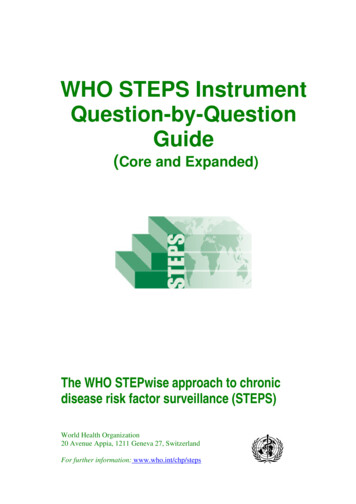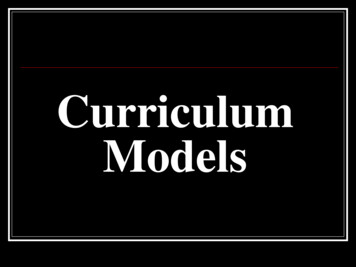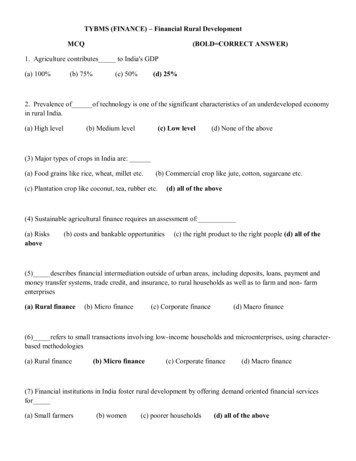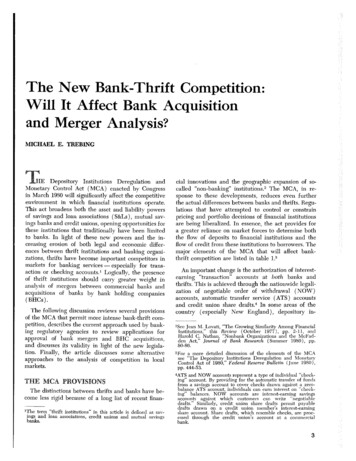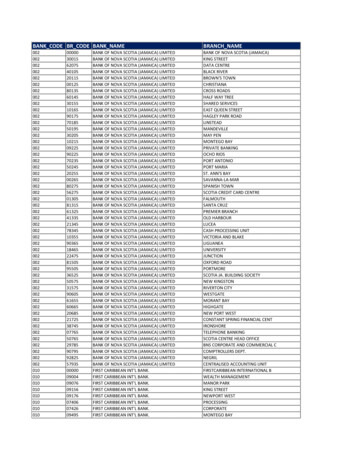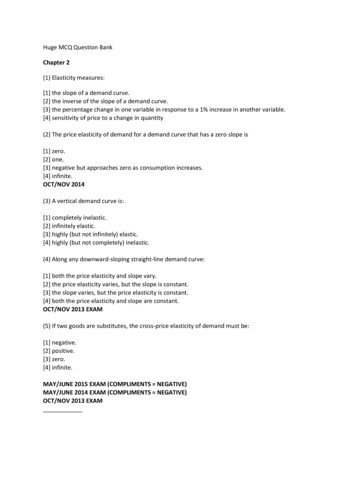
Transcription
Huge MCQ Question BankChapter 2(1) Elasticity measures:[1] the slope of a demand curve.[2] the inverse of the slope of a demand curve.[3] the percentage change in one variable in response to a 1% increase in another variable.[4] sensitivity of price to a change in quantity(2) The price elasticity of demand for a demand curve that has a zero slope is[1] zero.[2] one.[3] negative but approaches zero as consumption increases.[4] infinite.OCT/NOV 2014(3) A vertical demand curve is:[1] completely inelastic.[2] infinitely elastic.[3] highly (but not infinitely) elastic.[4] highly (but not completely) inelastic.(4) Along any downward-sloping straight-line demand curve:[1] both the price elasticity and slope vary.[2] the price elasticity varies, but the slope is constant.[3] the slope varies, but the price elasticity is constant.[4] both the price elasticity and slope are constant.OCT/NOV 2013 EXAM(5) If two goods are substitutes, the cross-price elasticity of demand must be:[1] negative.[2] positive.[3] zero.[4] infinite.MAY/JUNE 2015 EXAM (COMPLIMENTS NEGATIVE)MAY/JUNE 2014 EXAM (COMPLIMENTS NEGATIVE)OCT/NOV 2013 EXAM
(6) When the government controls the price of a product, causing the market price to be below thefree market equilibrium price:[1] some consumers gain from the price controls and other consumers lose.[2] all producers gain from the price controls.[3] both producers and consumers gain.[4] all consumers are better off.MAY/JUNE 2015 EXAMMAY/JUNE 2014 EXAM(7) What happens if price falls below the market clearing price?[1] Demand shifts out.[2] Supply shifts in.[3] Quantity demanded decreases, quantity supplied increases, and price falls.[4] Quantity demanded increases, quantity supplied decreases, and price rises.(8) Other things being equal, the increase in rents that occurs after rent controls are abolished issmaller when:[1] the own price elasticity of demand for rental homes is price inelastic.[2] the own price elasticity of demand for rental homes is price elastic.[3] the own price elasticity of demand for rental homes has unitary price elasticity.[4] rented homes and owned homes are complements.[5] rented homes and owned homes are substitutes.OCT/NOV 2014Answers:1 32 43 14 25 26 17 48 2Chapter 3(1) Which of the following is NOT an assumption regarding people's preferences in the theory ofconsumer behaviour?[1] Preferences are complete.[2] Preferences are transitive.[3] Consumers prefer more of a good to less.[4] All of the above are basic assumptions about consumer preferences
(2) The assumption of transitive preferences implies that indifference curves must:[1] not cross one another.[2] have a positive slope.[3] be L-shaped.[4] be convex to the origin.[5] all of the above.OCT/NOV 2014(3) Suppose that a market basket of two goods is changed by adding more of one of the goods andsubtracting one unit of the other, the consumer will:[1] rank the market basket more highly after the change.[2] more likely prefer a different market basket.[3] rank the market basket as being just as desirable as before.[4] be unable to decide whether the first market basket is preferred to the second or vice versa. [5]have indifference curves that cross.MAY/JUNE 2013 EXAM(4) A consumer prefers market basket A to market basket B, and prefers market basket B to marketbasket C. Therefore, A is preferred to C. The assumption that leads to this conclusion is:[1] transitivity.[2] completeness.[3] all goods are good.[4] diminishing MRS.[5] rationality.OCT/NOV 2013 EXAM(5) The slope of an indifference curve reveals:[1] that preferences are complete.[2] the marginal rate of substitution of one good for another good.[3] the ratio of market prices.[4] that preferences are transitive.[5] none of the above.MAY/JUNE 2014 EXAMMAY/JUNE 2013 EXAM
(6) A consumer has R100.00 per day to spend on product A, which has a unit price of R7.00, andproduct B, which has a unit price of R15.00. What is the slope of the budget line if good A is on thehorizontal axis and good B is on the vertical axis?[1] -7/15[2] -7/100[3] -15/7[4] 7/15MAY/JUNE 2015 EXAM – DIFFERENT NUMBERSMAY/JUNE 2014 EXAM – DIFFERENT NUMBERS(7) Suppose that the prices of good A and good B were to suddenly double. If good A is plotted alongthe horizontal axis,[1] the budget line will become steeper.[2] the budget line will become flatter.[3] the slope of the budget line will not change.[4] the slope of the budget line will change, but in an indeterminate way.OCT/NOV 2014(8) Theodore's budget line has changed from A to B. (See fig SG3.1 above.) Which of the followingexplains the change in Theodore's budget line?[1] The price of food and the price of clothing increased.[2] The price of food increased, and the price of clothing decreased.[3] The price of food decreased, and the price of clothing increased.[4] The price of food and the price of clothing decreased.[5] None of the above(9) If the quantity of good A (QA) is plotted along the horizontal axis, the quantity of good B (QB) isplotted along the vertical axis, the price of good A is PA, the price of good B is PB and the consumer’sincome is I, then the slope of the consumer’s budget constraint is .[1] -Qa/Qb[2] -Qb/Qa[3] -Pa/Pb[4] -Pb/Pa[5] I/Pa or I/Pb(10) The endpoints (horizontal and vertical intercepts) of the budget line:[1] measure its slope.[2] measure the rate at which one good can be substituted for another.[3] measure the rate at which a consumer is willing to trade one good for another.[4] represent the quantity of each good that could be purchased if all of the budget were allocatedto that good.[5] indicate the highest level of satisfaction the consumer can achieve.
(11) A consumer maximises satisfaction at the point where his valuation of good X, measured as theamount of good Y he would willingly give up to obtain an additional unit of X, equals:[1] the magnitude of the slope of the indifference curve through that point.[2] one over the magnitude of the slope of the indifference curve through that point.[3] Px/Py[4] Py/Px(12) Pencils sell for 10 cents and pens sell for 50 cents. Suppose Jack, whose preferences satisfy all ofthe basic assumptions, buys 5 pens and one pencil each semester. With this consumption bundle, hisMRS of pencils for pens is 3. Which of the following is true?[1] Jack could increase his utility by buying more pens and fewer pencils.[2] Jack could increase his utility by buying more pencils and fewer pens.[3] Jack could increase his utility by buying more pencils and more pens.[4] Jack could increase his utility by buying fewer pencils and fewer pens.[5] Jack is at a corner solution and is maximising his utility.OCT/NOV 2014OCT/NOV 2013 EXAM(13) An individual consumes only two goods, X and Y. Which of the following expressions representsthe utility maximising market basket?[1] MRSxy is at a maximum.[2] Px/Py money income.[3] MRSxy money income.[4] MRSxy Px/Py.[5] all of the above.(14) The fact that Alice spends no money on travel:[1] implies that she does not derive any satisfaction from travel.[2] implies that she is at a corner solution.[3] implies that her MRS does not equal the price ratio.[4] any of the above are possible.MAY/JUNE 2015 EXAMMAY/JUNE 2014 EXAM(15) The price of lemonade is R0.50; the price of popcorn is R1.00. If Fred has maximised his utility bypurchasing lemonade and popcorn, his marginal rate of substitution will be:[1] 2 lemonades for each popcorn.[2] 1 lemonade for each popcorn.[3] 1/2 lemonade for each popcorn.[4] indeterminate unless more information on Fred’s marginal utilities is provided.OCT/NOV 2013 EXAM
(16) Marginal utility measures:[1] the slope of the indifference curve.[2] the additional satisfaction from consuming one more unit of a good.[3] the slope of the budget line.[4] the marginal rate of substitution.[5] none of the above.(17) When someone consumes two goods (A and B), that person’s utility is maximised when thebudget is allocated such that:[1] the marginal utility of A equals the marginal utility of B.[2] the marginal utility of A times the price of A equals the marginal utility of B times the price of B[3] the ratio of total utility of A to the price of A equals the ratio of the marginal utility of B to theprice of A.[4] the ratio of the marginal utility of A to the price of A equals the ratio of the marginal utility of B tothe price of B.OCT/NOV 2014Answers:1 42 13 14 15 26 17 38 39 310 411 312 213 414 415 116 217 4Chapter 4(1) The change in the price of one good has no effect on the quantity demanded of another good.These goods are:[1] complements.[2] substitutes.[3] both inferior.[4] both Giffen goods.[5] none of the above.OCT/NOV 2014
(2) Which of the following is true regarding income along a price-consumption curve?[1] Income is increasing.[2] Income is decreasing.[3] Income is constant.[4] The level of income depends on the level of utilityOCT/NOV 2013 EXAM(3) Which of the following pairs of goods are NOT complements?[1] Hockey sticks and hockey pucks.[2] Computer CPUs and computer monitors.[3] On-campus student housing and off-campus rental apartments.[4] All of the above.[5] None of the above.(4) The price of good A goes up. As a result the demand for good B shifts to the left. From this wecan infer that:[1] good A is a normal good.[2] good B is an inferior good.[3] goods A and B are substitutes.[4] goods A and B are complements.[5] none of the above.(5) If an Engel curve has a positive slope,[1] both goods are normal.[2] the good on the horizontal axis is normal.[3] as the price of the good on the horizontal axis increases, more of both goods is consumed.[4] as the price of the good on the vertical axis increases, more of the good on the horizontal axis isconsumed.(6) Good A is a normal good. The demand curve for good A:[1] slopes downwards.[2] usually slopes downwards, but could slope upwards.[3] slopes upwards.[4] usually slopes upwards, but could slope downwards.(7) Refer to the following two statements in answering this question:I. All Giffen goods are inferior goods.II. All inferior goods are Giffen goods.[1] I and II are true.[2] I is true, and II is false.[3] I is false, and II is true.[4] I and II are false.
(8) The change in the quantity demanded of a good resulting from a change in relative price with thelevel of satisfaction held constant is called the effect.[1] Giffen[2] real price[3] income[4] substitution(9) For an inferior good, the income and substitution effects[1] work together.[2] work against each other.[3] can work together or in opposition to each other depending upon their relative magnitudes.[4] always exactly cancel each other.OCT/NOV 2014(10) The substitution effect of a price change for product X is the change in consumption of Xassociated with a change in:[1] the price of X, with the level of utility held constant.[2] the price of X, with the level of real income not considered.[3] the price of X, with the prices of other goods changing by the same percentage as that forproduct X.[4] income, with prices of other goods held constant.OCT/NOV 2013 EXAM(11) Refer to the following two statements to answer this question:I. The price elasticity of demand is constant along the entire length of a linear demandcurve.II. The price elasticity of demand is the special name that economists give to the slope ofa demand curve.[1] I and II are true.[2] I is true, and II is false.[3] I is false, and II is true.[4] I and II are false.(12) In a recent article, two economists estimated that the 37.5% increase in the price of cigarettesthat would result from a tax increase of 75 cents per packet of 20, would lead to a 30% decrease insmoking among college students. What can you conclude about the demand for cigarettes amongcollege students?[1] It is price elastic.[2] It is price inelastic.[3] It is unit elastic.[4] It is perfectly inelastic.
(13) As the price of good X increases from R5.00 to R8.00, quantity demanded falls from 100 to 80.Based upon this information, we can conclude that the demand for X is:[1] elastic.[2] inelastic.[3] unit inelastic.[4] insufficient information for judgment.(14) The demand for sirloin steak is probably more elastic than the demand for all meat, because:[1] sirloin steak is very expensive.[2] people are worried about cholesterol.[3] cattle-raising is not very profitable.[4] there are more substitutes for sirloin steak than for all meats.(15) Which of the following is true about the demand for petrol?[1] it is probably more price elastic in the long run because price will increase by a higherpercentage.[2] it is probably more price elastic in the long run because it is easier to find substitutes for petrol inthe long run.[3] it is probably more price elastic in the short run because price will increase by a higherpercentage.[4] it is probably more price elastic in the short run because it is easier to find substitutes for petrolin the short run.OCT/NOV 2014MAY/JUNE 2014 EXAM(16) The price of beef and quantity of beef traded are P* and Q*, respectively. Given thisinformation, consumer surplus is the area:Figure SG4.1: Figure for question (1)[1] 0BCQ*[2] ABC[3] ACP*[4] CBP*[5] 0ACQ*(17) When the price of wood (which is an input in the production of furniture) falls, the consumersurplus associated with the consumption of furniture[1] increases.[2] decreases.[3] does not change.[4] could be any of the above.
(18) The bandwagon effect corresponds best to which of the following?[1] Snob effect.[2] External economy.[3] Negative network externality.[4] Positive network externality.(19) Which of these is an example of a negative network externality?[1] Bandwagon effect.[2] Pollution.[3] Snob effect.[4] Two-part tariff.OCT/NOV 2014Answers:1 52 33 34 45 26 17 28 49 210 111 412 213 214 415 216 417 118 419 3Chapter 6(1) A production function assumes a given:[1] technology.[2] set of input prices.[3] ratio of input prices.[4] amount of capital and labour.[5] amount o
Huge MCQ Question Bank Chapter 2 (1) Elasticity measures: [1] the slope of a demand curve. [2] the inverse of the slope of a demand curve. [3] the percentage change in one variable in response to a 1% increase in another variable. [4] sensitivity of price to a change in quantity (2) The price elasticity of demand for a demand curve that has a zero slope is [1] zero. [2] one. [3] negative but .
